

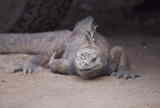
Position around: 0° 30' S - 90° 20' W
Pacific Ocean
Until april in 2008 I traveled 54 times around the sun together with our planet earth. It might be 47 years ago, that I watched a report about the Galapagos Islands in TV. As far as I remember, a very famous German zoologist Prof. Grzimek did that report. I saw an iguana (I call them dragons) coming slowly from behind a large rock. Standing there in half profile. That picture from that moment on was fixed in my brain. And now, I saw these famous creatures in real life.
Please mind, I call them dragons, but these animals are absolutly hamless!

|
 |

|
Literature:
(1) John C. Kricher, Galapagos, 2002, Smithsonian Institution
Press Washington & London , ISBN 1-58834-041-4
(2) NN, Independent traveler Galapagos handbook, Flying Fish Publication
Guayaquil, first edition December 2000 , ISBN 9978-41-353-7
(3) Andy Swash, Rob Still, Birds, mammals, & Reptiles of the Galapagos
Islands, Yale University Press New Haven and London, ISBN
0-300-08864-7
(4) Rob Rachowiecki, Danny Palmerlee, Ecuador & the Galapagos Islands,
Lonely Planet Publications Melbourne-Oakland-London-Paris, 6th
edition August 2003, ISBN 1-74059-464-9
(5) Carmen Rohrbach, Inseln aus Feuer und Meer - Galapagos-Archipel der zahmen
Tiere, National Geographics Adventure Press, 5. Auflage November 2003, ISBN
3-89405-027-6
(6) Galapagos Islands (Ecuador) Scale 1:500000, International Travel Map
308, ITMB Publishing LTD. 1998, ISBN 155341559-0
(7) Ecuador 1:1000000, Berndtson Map, ISBN 3-89707-053-7
(8) Wolfgang Bittmann, Brigitte Fugger, Galapagos, Tecklenborg Verlag Steinfurt
2007, 5. Auflage, ISBN 3-934427-77-4
Thursday, October 25th 2007
The Spanish word gálapago stands for tortoise or Schildkroete (the German name). The islands which I will visit are named after the "gálapago". I am on the way to Ecuador, to visit the Galapagos Islands.
Munich's fast train (S-Bahn) are on strike, so I choose to take a taxi to go to the airport. That was a good choice because it was more convenient. I need to go from Munich to Madrid and then to Quito. In Quito I have to stay one night and will continue the next day to Baltra airport on Galapagos.
It takes two hours or so to go to Madrid and then additional eleven hours to go to Quito, the capital of Ecuador. Landing in Quito, the first I saw, was a little boy who played with a ball inside a big aircraft-hangar close to the runway. By the way, during the approach around Quito there have been a lot of cumulonimbus up to 30000feet. As usual for the most countries, it was necessary to fill out some immigration paperwork. That was not much but the paperwork was provided in Spanish only. My dictionary worked well. The immigration it self was without any problems. With a taxi I drove for about $10 to my hotel. Later on at the hotel I met Willi, the manager from the travel agency which organized the hotels and also the boat tour around the islands.
It is a very nice custom, the rooms in the hotels do not have numbers, they have names. Also, in the hotel I to open the case which contains my camera and lenses. The case is water-proved. Remember that for later in this report, I am now on about 3000m altitude (about 10000feet).
By the way, I was very pleased with Willi's organization. He is from Switzerland and is running a travel agency in Quito, Ecuador. Please visit Positiv Turismo or mosaikoequador.
Friday, October 26th 2007
Getting up early, because the flight to Baltra is early in the
morning. I took a taxi to the airport, without breakfast. The first action
 at
the airport was the special check of the luggage. I do not mean the usual
security check. All people who go to Galapagos, need a special luggage check.
It is checked, that nobody brings plants, animals or other organic material
onto the islands. Such unwanted material can influence the ecological balance
on Galapagos Islands.
That
at
the airport was the special check of the luggage. I do not mean the usual
security check. All people who go to Galapagos, need a special luggage check.
It is checked, that nobody brings plants, animals or other organic material
onto the islands. Such unwanted material can influence the ecological balance
on Galapagos Islands.
That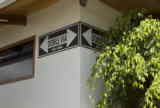 such
things had happen in the past, please refer to (1). The flight was about
2 hours and 30 minutes via Guayaquill.
such
things had happen in the past, please refer to (1). The flight was about
2 hours and 30 minutes via Guayaquill.
The airport on Baltra is like a little landing site. There is a
landing stripe and a few huts. A lot of these huts outside the airport are
souvenir shops. Baltra is a small island north of Isla Santa Cruz. The
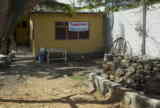 airport
on Baltra was introduce long time ago as a military base. Baltra belongs
to the Ecuadorian army, not to the Galapagos National Park (2).
airport
on Baltra was introduce long time ago as a military base. Baltra belongs
to the Ecuadorian army, not to the Galapagos National Park (2).
After leaving the aircraft, the first action was a carry-on luggage
inspection. Nobody should bring food out of the aircraft. The next action
was paying the Galapagos National Park fee of $100 (October 2007). Then I
tried to open my water proofed case to have my camera ready. I was unable
to open the case. Do you remember? I open the case in Quito on 3000m altitude.
Now I was on sea level. The outside air pressure was so big, that I was unable
to open the case. Now I understood the reason for this build-in compensation
vent. I open the vent, it makes a noise and I was able to open the case.
Now the luggage was placed under a roof and then everybody could take his
luggage. In Quito and also here in Baltra every luggage was checked by an
airport employee
 that nobody
took the wrong case out.
that nobody
took the wrong case out.
The most people coming to Galapagos Islands are going on a boot
tour immediately after arriving. I did not want to do so. After more then
half a day on aircrafts and six or seven hours in time difference I was very
unsure to stand this.
 It was a very
good idea to stay a few days before and after the boot tour in Puerto Ayora
on Isla Santa Cruz.
It was a very
good idea to stay a few days before and after the boot tour in Puerto Ayora
on Isla Santa Cruz.
Baltra and Isla Santa Cruz are separated by a small canal. The
next business was to go to Puerto Ayora. There is a free bus from the airport
to the canal and from the airport to the dock. The most boot tours
start at the dock. I choose the bus to "El Cannal". The other bus by the
way is named "El Muelle". After a short ride I arrive at the canal
(Canal de Itabaca). A little ferry was waiting. I put my luggage on the roof
of the ferry and went
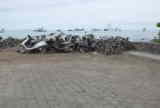 into
the boot. Under some circumstances the ride costs 50cent sometimes 80cent.
I did not find out why these difference. In (2) it is described to grab a
live jacket. That was not necessary anymore. Also (2) talks about some aggressive
people. I did not encounter aggressive people, I always find friendly people.
Even
into
the boot. Under some circumstances the ride costs 50cent sometimes 80cent.
I did not find out why these difference. In (2) it is described to grab a
live jacket. That was not necessary anymore. Also (2) talks about some aggressive
people. I did not encounter aggressive people, I always find friendly people.
Even
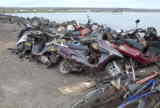 the people tried to speak English. However, it is always
a good idea to have a few Spanish expressions ready for use.
the people tried to speak English. However, it is always
a good idea to have a few Spanish expressions ready for use.
At Isla Santa Cruz I headed to the next bus. I already had the ticket which was sold at the airport. One crazy taxi driver wanted me to believe that the next bus is going in one hour. He told a lie. The bus was ready to go in a few minutes. Some days later I had an other bad experience with a taxi driver, he returned the wrong change and "escaped".
After one hour bus ride, I arrived in Puerto Ayora. The friendly bus driver stopped directly in front of my hotel. The hotel seems to be very new. It has a nice flavor. It is about noon now. After having a shower I was ready to explore Puerto Ayora.
The first animals I saw was a brown pelican and a frigate bird. Both birds are very large in size. Whereas the frigate bird is always a very excellent flyer. In the back yard of the local police station I found a lot of broken motor bikes and the first dragons. My first impression was, these dragons are made out of plastic and placed there like garden gnomes. But no, these dragons are alive!
Later on it was time to have something to eat. The restaurant was good, but the service was poor and the prices to high. But that I realized a few days later. The first day on Galapagos comes to the end.
Saturday, October 27th 2007
It is cloudy but warm. The breakfast in the hotel is very good.
There is no buffet, everything is served at the table. They have
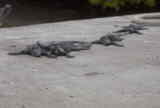 bread,
rolls, very good juice, fruits, yoghurt, milk and coffee, cheese, sausage
and more.
bread,
rolls, very good juice, fruits, yoghurt, milk and coffee, cheese, sausage
and more.
It is a short walk from the hotel to Darwin Station. A lot of souvenir
shops are located on the way to Darwin Station. The souvenirs mostly are
not nice done (for my opinion). It is not recommend to buy. However, there
have been two may be three shops which provide well done artwork. At the
main road was a shop which sold large well done pictures about Galapagos
landscapes and animals. An other shop more close to Darwin Station sold
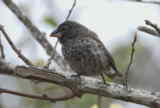 a
wide palette of well done art. I guess a German runs that shop. All the other
souvenir shops disappointed me.
a
wide palette of well done art. I guess a German runs that shop. All the other
souvenir shops disappointed me.
Arriving at the Darwin Station, I found out, there is a way around
to walk. Also it is possible to go to the little dock. Some dragons and a
great blue herons are there. On the round way through the Darwin Station
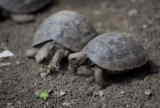 there
are a lot of naughty small birds, many tortoise and a few large dragons.
These dragons in Darwin Station are the largest I have seen on Galapagos.
I could walk through the tortoise terrain, close to the amazing large animals.
In (1) is mentioned that Darwin called them "These Great
there
are a lot of naughty small birds, many tortoise and a few large dragons.
These dragons in Darwin Station are the largest I have seen on Galapagos.
I could walk through the tortoise terrain, close to the amazing large animals.
In (1) is mentioned that Darwin called them "These Great
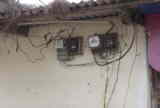 Monsters".
I do not think, tortoises are "monsters". May be Darwin called the tortoise
monsters in the same way as I call the iguanas dragons. I also have seen
large tortoises on Ascension. These animals are amazing. They are more afraid
about humans then the humans must be afraid about tortoise. However, do not
put your fingers close to the tortoise's mouth, the fingers will be cut off.
Monsters".
I do not think, tortoises are "monsters". May be Darwin called the tortoise
monsters in the same way as I call the iguanas dragons. I also have seen
large tortoises on Ascension. These animals are amazing. They are more afraid
about humans then the humans must be afraid about tortoise. However, do not
put your fingers close to the tortoise's mouth, the fingers will be cut off.
Later at the day I walked a bit inside Puerto Ayora. There are
houses with gardens, restaurants, shops, supermarkets,
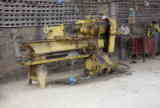 etc.
Also I have seen such kind of large sport hall and a soccer field. The hall
was not completed closed. Between the roof and the walls around was a little
gap. A kind of "air condition". An other hall just has a roof, everything
else is open. By the way, the electric wiring is done a bit on a
lazy
etc.
Also I have seen such kind of large sport hall and a soccer field. The hall
was not completed closed. Between the roof and the walls around was a little
gap. A kind of "air condition". An other hall just has a roof, everything
else is open. By the way, the electric wiring is done a bit on a
lazy way (see picture
above).
way (see picture
above).
Later on I found a nice cafe close to a lagoon. This cafe was different to others. It owns a gecko which lives behind a large wall-clock inside the cafe. This gecko is responsible to keep the cafe free of flies. Also there was a library upstairs in this cafe. However, they had the best chocolate-cake on Galapagos.
Sunday, October 28th 2007
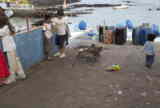 During
night it was rainy. The sun raised but I could not see the sun due to clouds.
During
night it was rainy. The sun raised but I could not see the sun due to clouds.
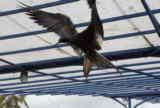 It
becomes colder suddenly. A lot of birds are singing, some of them very loud.
After breakfast I went down to the fish market. That was the funniest fish
market I ever had seen. The fisherman sold the fish. That is very usual.
But around where about thirty pelicans waiting for food. The pelicans are
well educated, they did not touch the fish to sell, they lined up for the
stuff which could not be sold. If a pelican
It
becomes colder suddenly. A lot of birds are singing, some of them very loud.
After breakfast I went down to the fish market. That was the funniest fish
market I ever had seen. The fisherman sold the fish. That is very usual.
But around where about thirty pelicans waiting for food. The pelicans are
well educated, they did not touch the fish to sell, they lined up for the
stuff which could not be sold. If a pelican
 gets
such food, other pelicans wanted to have
gets
such food, other pelicans wanted to have
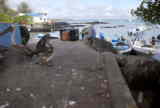 the
same food too. So a fight starts. If one pelican could escape with the food,
the frigate birds came out of the air and tried to steel the food. If one
frigate bird gets some food other frigate birds also tried to get the food
from the frigate bird which has the food. I watched the game for several
hours.
the
same food too. So a fight starts. If one pelican could escape with the food,
the frigate birds came out of the air and tried to steel the food. If one
frigate bird gets some food other frigate birds also tried to get the food
from the frigate bird which has the food. I watched the game for several
hours.
Later at the day I returned to the fish market. A sea lion swims
around, some fisherman tried to catch fish and a large ray or skate was
swim ming around. It had a very large tail-thorn.
ming around. It had a very large tail-thorn.
Tomorrow I will go onto the ship. The boot tour will start. I am a bit unsure, I hope to have nice people on board because with this the tour will successful or fall through. By the way, the tour was successful.
The Boat Tour
The Galapagos are located around the Equator about 1000km west
of South America. Galapagos
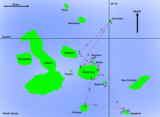 belongs
to Ecuador. The surface of all Islands together is about 7900square-km. 96%
of the land belongs to the "Galapagos National Park" and 4% of the islands
is populated or belongs to the Army (8). A lot information about the history
and the geology is found in (1) and in (8). Also a bit in (2), (4) and (5).
The names of the islands differ from publication to publication. I use the
names stated in the map of (1), where also is found a cross reference to
all the different names and a description about the origin of the island
names. Due to the sensitive nature, it is not allowed to enter the Galapagos
National Park without a licensed guide. The park roles published in the most
books about Galapagos must be followed (3), (8).
belongs
to Ecuador. The surface of all Islands together is about 7900square-km. 96%
of the land belongs to the "Galapagos National Park" and 4% of the islands
is populated or belongs to the Army (8). A lot information about the history
and the geology is found in (1) and in (8). Also a bit in (2), (4) and (5).
The names of the islands differ from publication to publication. I use the
names stated in the map of (1), where also is found a cross reference to
all the different names and a description about the origin of the island
names. Due to the sensitive nature, it is not allowed to enter the Galapagos
National Park without a licensed guide. The park roles published in the most
books about Galapagos must be followed (3), (8).
An organized boat tour is the best and I guess the only way to
explore the Galapagos. The people mostly doing it like this: They are flying
from all over the world to Baltra, running to the boat, doing the tour 4
or 8 days, running back to the airport and flying home. If you have 10 days
of vacation
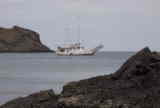 per year,
that might be the best to get an impression. However, the way to do so is
more stressful then work. I prefer the relaxed way, I had flown from Munich
via Madrid to Quito. I continued the next day to Baltra and stayed three
days in Puerto Ayora on Santa Cruz before I embarked onto the boat. Please
refer to the map above. The tour started on Baltra, marked by the blue
dot and the blue
"X". Then follow the lines, arrows and numbers.
All stations on the 8 days tour with S/Y Angelique will be described in brief
below. After disembarking the boat, I additional stood three days in Puerto
Ayora before I returend to Germany.
per year,
that might be the best to get an impression. However, the way to do so is
more stressful then work. I prefer the relaxed way, I had flown from Munich
via Madrid to Quito. I continued the next day to Baltra and stayed three
days in Puerto Ayora on Santa Cruz before I embarked onto the boat. Please
refer to the map above. The tour started on Baltra, marked by the blue
dot and the blue
"X". Then follow the lines, arrows and numbers.
All stations on the 8 days tour with S/Y Angelique will be described in brief
below. After disembarking the boat, I additional stood three days in Puerto
Ayora before I returend to Germany.
S/Y Angelique is a small sailer and power driven boat. It has space for 16 passengers (two on each cabin), the guide, the captain, the chef (he really was famous), the engineer, the "captain of dinghy" and the bar-tender. The chef was famous, because he did the breakfast, lunch and dinner for all passengers in his small kitchen in a way that he easily cold measure with a chef in a very good restaurant. I am very pleased with him.
Monday, October 29th 2007
Getting up at 5 o'clock in the morning, ready to go to the airport.
But first, I had a good breakfast. The airport is the meeting point
to start the boot-tour. After breakfast I drove with a pick-up taxi to the
canal. It took 30 minutes for about 40km. The driver charged $15. During
the drive I saw
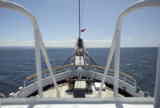 different
landscapes, first dry, then green and then dry again. The ferry charged 80ct
this time. The
different
landscapes, first dry, then green and then dry again. The ferry charged 80ct
this time. The
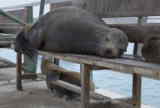 most passengers are
TAME people who will wake up the airport. The people are very friendly. I
am unable to confirm the description about unfriendlines like in (2).
most passengers are
TAME people who will wake up the airport. The people are very friendly. I
am unable to confirm the description about unfriendlines like in (2).
At the airport I meet the guide named Edwin. A very small man but
with a real ability to handle different kind of human beings. Also he speaks
very well English and has a lot of
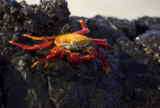 knowledge about the
Galapagos Islands. After having every Angelique passengers together, we took
the bus to "El Muelle". As usual on Galapagos, it is necessary to use the
dinghy to embark the ship. To do so, I had to pass a few
knowledge about the
Galapagos Islands. After having every Angelique passengers together, we took
the bus to "El Muelle". As usual on Galapagos, it is necessary to use the
dinghy to embark the ship. To do so, I had to pass a few
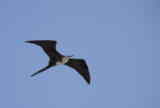 benches. Usually
done for humans to relax. These benches are occupied by sealions, not usable
for humans anymore (see pictue above, left).
benches. Usually
done for humans to relax. These benches are occupied by sealions, not usable
for humans anymore (see pictue above, left).
The first navigation (as Edwin used to say) went to Punta Bowditch. It is located at the north-east cost of Isla Santa Cruz (#1). To my knowledge the point is named after a water supply tour in the 40th which ended up into an accident and failed. Some steal structures remembered to that accident. A lot of crabs and sea birds (frigates, pelicans and boobies) are at Punta Bowditch.
Later in the evening there where sharks around Angelique. The sharks where hunting sealions and pelicans.
By the way, at noon the chef provided an excellent lunch and a very good dinner to night time. He did that every day!
Tuesday, October 30th 2007
After a night navigation the ship arrived at Isla Genovesa
(#2). It is cloudy
and a bit fresh. Due to the night navigation, I am not sure whether
I did sleep or not. It is noisy and the ship moves in all directions. However,
I am feeling well. Many other ships are
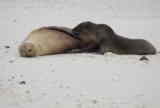 there. Everybody
will go onto the island. But fist a good breakfast on our sailer.
there. Everybody
will go onto the island. But fist a good breakfast on our sailer.
Our ship anchors inside an old crater. The island slowly returns
down into the sea. However, before the island will return to it's roots,
we will visit
 a few interesting
animals. Special gulls which are only available on this island, boobies with
red feet, sea lions and of cause dragons.
a few interesting
animals. Special gulls which are only available on this island, boobies with
red feet, sea lions and of cause dragons.
 The
swallow-tailed gull which is endemic on Galapagos was seen several
times. The gulls live together for their whole life. Sea lions are laying
at the beach. The poor sea lion pup likes to get milk from the mother. The
mother usually did not allow it on the
The
swallow-tailed gull which is endemic on Galapagos was seen several
times. The gulls live together for their whole life. Sea lions are laying
at the beach. The poor sea lion pup likes to get milk from the mother. The
mother usually did not allow it on the
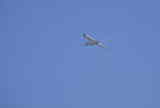 easy
way. It is not easy to be a sea lion pup on Galapagos. The red footed boobies
are available in gray and in white. About 95% of the Galapagos red footed
booby population is brown. The yellow-crowned night-heron
usually
easy
way. It is not easy to be a sea lion pup on Galapagos. The red footed boobies
are available in gray and in white. About 95% of the Galapagos red footed
booby population is brown. The yellow-crowned night-heron
usually
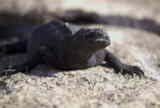 hunts during
the night. We have seen that large bird during day time. In the afternoon
we saw a very special bird, which flies very fast. It is called red-billed
tropicbird. Including tail, the bird a about 1m in length and the wingspan
is also about 1m. The bird has very long white tail streamers. Due
to the high speed of that bird, it is extremely difficult to make pictures.
hunts during
the night. We have seen that large bird during day time. In the afternoon
we saw a very special bird, which flies very fast. It is called red-billed
tropicbird. Including tail, the bird a about 1m in length and the wingspan
is also about 1m. The bird has very long white tail streamers. Due
to the high speed of that bird, it is extremely difficult to make pictures.
The animals are very close usually. Mainly they are not afraid about the visitors. That is the amazing behavior of the Galapagos animals. The birds remember me to the behavior of the little nutcrackers in the Olympic State park in the USA. I visit that park in 1988. A lot of these birds where around me and tried to get peanuts out of my hands. Some of the little nutcrackers landed on my fingers and arms.
Wednesday, October 31th 2007
An other night navigation leads us to Bartolomé. It is a
small island close to Santiago
(#3).
Mainly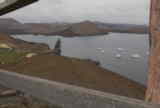
 that island
is known for it's landscape. Bartolomé is the most visit island in
the Galapagos archipelago. There are not much animals. A few lizards, very
shy snakes (we have not seen snakes) and a small number of dragons. The live
takes place at the cost. There are egg-grounds for sea turtles. Also we have
seen galapagos-penguins from our dinghy. Yes, on Galapagos we do have the
most northern penguins of the world.
that island
is known for it's landscape. Bartolomé is the most visit island in
the Galapagos archipelago. There are not much animals. A few lizards, very
shy snakes (we have not seen snakes) and a small number of dragons. The live
takes place at the cost. There are egg-grounds for sea turtles. Also we have
seen galapagos-penguins from our dinghy. Yes, on Galapagos we do have the
most northern penguins of the world.
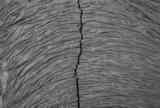
 In
the morning we walked up on well prepared steps to get the "picture-postcard
view" of Bartolomé. It is a never forgettable view on this famous
landscape.
In
the morning we walked up on well prepared steps to get the "picture-postcard
view" of Bartolomé. It is a never forgettable view on this famous
landscape.
In the afternoon we walked over the island's lava fields. The lava
is black.
W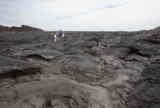 alking over it
sometimes sounds like walking over porcelain. A few plants erect out of the
lava and lava-gaps. The cold lava shows very bizarre forms. Walking over
that lava remembers me on my lava-walk on Ascension (please refer to my
Ascension page).
alking over it
sometimes sounds like walking over porcelain. A few plants erect out of the
lava and lava-gaps. The cold lava shows very bizarre forms. Walking over
that lava remembers me on my lava-walk on Ascension (please refer to my
Ascension page).
I had a glass of wine with the dinner. The sailer had a strong move. The wine and the movement together forced a sea-sickness. From now on I avoid the wine.
Thursday, November 1st 2007
The seasickness I had yesterday evening after dinner is gone. I
am well again. The last
night navigation
ends up in Puerto Ayora harbour. There is a light rain. It is breakfast and
after
navigation
ends up in Puerto Ayora harbour. There is a light rain. It is breakfast and
after
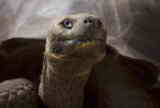 breakfast
we will visit Puerto Ayora on Santa Cruz Island. The location now is
(#4) on the map
above. I explained before, the Darwin Station is located in Puerto Ayora.
We will visit Darwin Station and later on during the day we will visit a
lava cave and an area which host a lot of large tortoises. For the most travelers
this would be the only possibility to buy souvenirs. Some time is reserved
for shopping. However, after landing at Puerto Ayora, we saw a nice blue
heron, slowly and
breakfast
we will visit Puerto Ayora on Santa Cruz Island. The location now is
(#4) on the map
above. I explained before, the Darwin Station is located in Puerto Ayora.
We will visit Darwin Station and later on during the day we will visit a
lava cave and an area which host a lot of large tortoises. For the most travelers
this would be the only possibility to buy souvenirs. Some time is reserved
for shopping. However, after landing at Puerto Ayora, we saw a nice blue
heron, slowly and
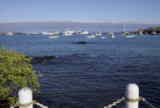 carefully
walking inside the water. Later we additionally saw that large blue heron
at the fish market.
carefully
walking inside the water. Later we additionally saw that large blue heron
at the fish market.
First we headed into the direction of Darwin Station. From the
landing site we where put into taxis and we drove the short way to Darwin
Station. At the
station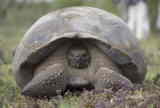 we did the
same walk I had done a few days before. But I had seen Lonesome George now.
The last tortoise of his sub-species from Pinta Island. Land tortoises are
fantastic animals. Tortoises are well known for their high age (up to much
more then 100 years). Our guide was not sure about it. He had spoken about
an age of 70 years. Everything about tortoise-age seems to be a guesswork.
I do not have any confirmed information about how old a tortoise can be.
we did the
same walk I had done a few days before. But I had seen Lonesome George now.
The last tortoise of his sub-species from Pinta Island. Land tortoises are
fantastic animals. Tortoises are well known for their high age (up to much
more then 100 years). Our guide was not sure about it. He had spoken about
an age of 70 years. Everything about tortoise-age seems to be a guesswork.
I do not have any confirmed information about how old a tortoise can be.
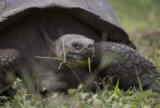 We
left the Station and now shopping was on the schedule. I did not what to
go shopping. As I stated before, there is a very low number of good souvenir
shops only. I preferred to go to the lagoon cafe to have a chocolate
cake.
We
left the Station and now shopping was on the schedule. I did not what to
go shopping. As I stated before, there is a very low number of good souvenir
shops only. I preferred to go to the lagoon cafe to have a chocolate
cake.
From the meeting point at the harbour we returned to our sailer
for lunch. After
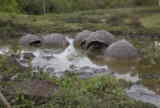 lunch
we returned to Puerto Ayora for a bus ride to a lava cave north of Puerto
Ayora. Such cave is very impressing. After an other short bus ride, we arrived
an area to observe tortoises in there natural environment. The behavior of
the animals was different to the behavior of the animals in the Darwin Station.
The free tortoises seem to be afraid. The animals sometime completely covered
their neck and head. The tortoises in that area are land tortoises. Even
they like to sit in water.
lunch
we returned to Puerto Ayora for a bus ride to a lava cave north of Puerto
Ayora. Such cave is very impressing. After an other short bus ride, we arrived
an area to observe tortoises in there natural environment. The behavior of
the animals was different to the behavior of the animals in the Darwin Station.
The free tortoises seem to be afraid. The animals sometime completely covered
their neck and head. The tortoises in that area are land tortoises. Even
they like to sit in water.
We returned to Puerto Ayora and to our sailer. Today we will get a new guide on our ship. The new guide arrived very late. He arrived around midnight and we headed to south.
Friday, November 2nd 2007
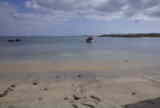 We are
in a small bay. The island is called Floreana. That is
(#5) on the map
above. It is cloudy, the sea is calm. After our good breakfast we did a dinghy
ride
We are
in a small bay. The island is called Floreana. That is
(#5) on the map
above. It is cloudy, the sea is calm. After our good breakfast we did a dinghy
ride
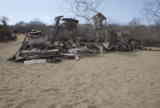 to Floreana. It
is the first excursion with our new guide. An old letterbox is located on
Floreana. That letterbox belongs to the mail service out of the beginning
of sea voyages. The sailors deposit their mail in such mailbox and
they took mail out to deliver it. That was a nice custom and the only way
of communication in the old days of sea voyages. Nowadays such mailbox is
for fun. However, I placed a postcard. The delivery of that postcard was
to Floreana. It
is the first excursion with our new guide. An old letterbox is located on
Floreana. That letterbox belongs to the mail service out of the beginning
of sea voyages. The sailors deposit their mail in such mailbox and
they took mail out to deliver it. That was a nice custom and the only way
of communication in the old days of sea voyages. Nowadays such mailbox is
for fun. However, I placed a postcard. The delivery of that postcard was
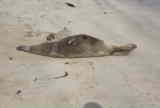 faster than
by regular mail!
faster than
by regular mail!
The next attraction is located in the underworld. We additional
want to visit a lava cave. That cave goes down into the ocean. A scuba diver
would be able to go trough that cave into the Pacific. We saw the water.
Our guide requested
to switch off all
light and also he requested to stop talking -> timeless infinity, can
you imagine......
switch off all
light and also he requested to stop talking -> timeless infinity, can
you imagine......
On the way back the guide took me to a "secret" passage. Everybody else could follow but nobody wanted to do, because the entrance is very small. I had to walk on all four like a dragon.
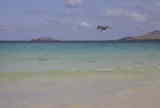 Now we
had time to swim. I went into the water, swim a while and a sealion came
along to say "hello". We always had our lunch on the sailer. It is not allowed
to take food onto the Galapagos islands. Water is allowed. After lunch we
returned and walked over to a lagoon. At the lagoon we saw flamingos, pink
ones. Also white ones should be there. Further on we arrived at a bay. The
sand is used by sea-tortoises to lay eggs. A few tortoise have been in the
sea but did not come onto the beach. They come out to night only.
Now we
had time to swim. I went into the water, swim a while and a sealion came
along to say "hello". We always had our lunch on the sailer. It is not allowed
to take food onto the Galapagos islands. Water is allowed. After lunch we
returned and walked over to a lagoon. At the lagoon we saw flamingos, pink
ones. Also white ones should be there. Further on we arrived at a bay. The
sand is used by sea-tortoises to lay eggs. A few tortoise have been in the
sea but did not come onto the beach. They come out to night only.
We return to the sailer by the dinghy to have dinner.
Saturday, November 3rd 2007
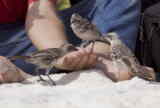 We are
at Espanola now
(#6). The night
navigation was a bit
We are
at Espanola now
(#6). The night
navigation was a bit
 rough. The bay
is full of sealions. About 500 or so. We had our fine breakfast and we wait
for the dinghy. The captain by the way is doing some repair work at the ship's
handrail. He does it very well.
rough. The bay
is full of sealions. About 500 or so. We had our fine breakfast and we wait
for the dinghy. The captain by the way is doing some repair work at the ship's
handrail. He does it very well.
We arrived on the island. A few very naughty birds welcome us,
hood mockingbirds. Our guide let us walk along the beach. The sand is white
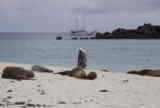 and reflects
and reflects
 the sun.
I can not walk without shoes due to the hot sand. On my way along the beach
I saw many sealions, dragons, lizards and sea-tortoises. Due to the
bright sunlight taking pictures was difficult. I had to manage the high
contrasts. Our guide is a bit lazy, he sits in the shadow and watches after
the people. He needs to do that because he at the end is responsible and
also he has to advice the people if somebody is doing something wrong even
if it is happen accidentally. Please see the picture above, the mockingbirds
can not read
the sun.
I can not walk without shoes due to the hot sand. On my way along the beach
I saw many sealions, dragons, lizards and sea-tortoises. Due to the
bright sunlight taking pictures was difficult. I had to manage the high
contrasts. Our guide is a bit lazy, he sits in the shadow and watches after
the people. He needs to do that because he at the end is responsible and
also he has to advice the people if somebody is doing something wrong even
if it is happen accidentally. Please see the picture above, the mockingbirds
can not read
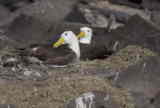 but we can
read. It is not allowed to touch the animals. The person "attacked"
but we can
read. It is not allowed to touch the animals. The person "attacked"
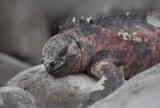 by the mockingbirds
had slowly to move away. However, the birds where follow him up. I do not
remember how he gets rid of the birds. The beach was amazing.
by the mockingbirds
had slowly to move away. However, the birds where follow him up. I do not
remember how he gets rid of the birds. The beach was amazing.
Now we moved on a bit and we arrived at
(#7). The point
where
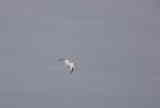 we
would be able to observe the albatross. You know albatrosses from Bernhard
and Bianca? I have not seen how they perform their landing. It is fantastic
to observe the large birds in the air. About 12000 (twelfthousend) Galapagos
albatross couples do have their hatchery on Espanola (8). Albatross couples
live together the whole life. Their
we
would be able to observe the albatross. You know albatrosses from Bernhard
and Bianca? I have not seen how they perform their landing. It is fantastic
to observe the large birds in the air. About 12000 (twelfthousend) Galapagos
albatross couples do have their hatchery on Espanola (8). Albatross couples
live together the whole life. Their
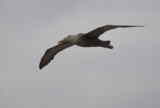 behavior
looks very tenderly.
behavior
looks very tenderly.
We have been for longer at the albatross place, about 50m or
 so above the sea.
We could observe many birds flying along the coastline. A large number of
these fast red-billed tropic birds flown around. Also boobies and gulls.
We went on, passing the blow-hole and returned back to our sailer.
so above the sea.
We could observe many birds flying along the coastline. A large number of
these fast red-billed tropic birds flown around. Also boobies and gulls.
We went on, passing the blow-hole and returned back to our sailer.
 I ask the
ship's engineer about his engines. He explained the
large
I ask the
ship's engineer about his engines. He explained the
large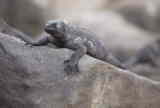 main engine. The
starter is electrical. Compressed air air is not necessary to start up the
engine. It is a small ship. Additional he has to run two generators to provide
electricity. The sailer has 120V 60Hz (USA standard) installation.
main engine. The
starter is electrical. Compressed air air is not necessary to start up the
engine. It is a small ship. Additional he has to run two generators to provide
electricity. The sailer has 120V 60Hz (USA standard) installation.
The day ends as usual with a famous dinner.
Sunday, November 4th 2007
The navigation tonight was short. The sea was calm. We arrived
at Santa Fe which is
(#8) on the
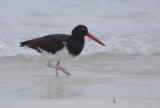 map
above. It is cloudy and a bit fresh. We are in a bay, some other ships are
there too. Sealions are crying. These sealions usually lay together peaceful.
However, if they hiss to each other they do it like human. Or may be the
human hiss like
map
above. It is cloudy and a bit fresh. We are in a bay, some other ships are
there too. Sealions are crying. These sealions usually lay together peaceful.
However, if they hiss to each other they do it like human. Or may be the
human hiss like
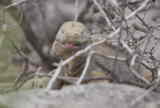 sealions? The
island Santa Fe hosts a lot of cactus plants. The rings around the tree trunk
give information about the tree's age. The distance between two rings is
25 years as the guide explained. We count the
sealions? The
island Santa Fe hosts a lot of cactus plants. The rings around the tree trunk
give information about the tree's age. The distance between two rings is
25 years as the guide explained. We count the
 rings of one cactus
and find it is 200 years old. At the coastline we saw an american oystercatcher.
The dragons on the island where camouflage. We had problems to find these
land dragons. The few we saw are large and beautyfull and naughty (see picture
to the upper left). We return to the sailer by the dinghy.
rings of one cactus
and find it is 200 years old. At the coastline we saw an american oystercatcher.
The dragons on the island where camouflage. We had problems to find these
land dragons. The few we saw are large and beautyfull and naughty (see picture
to the upper left). We return to the sailer by the dinghy.
It is time to rearrange the backpack. Tomorrow the cruise is over.
But first we
are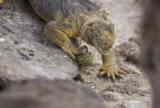 going
full speed to Plaza Sur
(#9). A small island
close to Santa Cruz' west coast. A
going
full speed to Plaza Sur
(#9). A small island
close to Santa Cruz' west coast. A
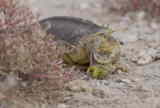 lot
of dragons where out. These dragons eating cactus leaves or cactus flowers.
As they also do on Santa Fe. First the dragons clean the leaves from thorns
then they eat it. To clean the dragons fix the leave or the flower with one
of their front hands. The other hand skims over the leave or the flower several
times. After that procedure the thorns mostly gone. The dragon can eat. It
is amazing to observe the little dragons doing that cleaning.
lot
of dragons where out. These dragons eating cactus leaves or cactus flowers.
As they also do on Santa Fe. First the dragons clean the leaves from thorns
then they eat it. To clean the dragons fix the leave or the flower with one
of their front hands. The other hand skims over the leave or the flower several
times. After that procedure the thorns mostly gone. The dragon can eat. It
is amazing to observe the little dragons doing that cleaning.
Now we returned back to the sailer for dinner, the last dinner on Angelique.
Monday, November 5th 2007
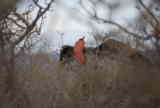 Our sailer
now anchored close to Seymour which is
(#10) in the map
above. We need to get up very early in the morning. We will visit Seymour
before breakfast. My backpack already is packed. We should find dragons but
it seems they are
on
Our sailer
now anchored close to Seymour which is
(#10) in the map
above. We need to get up very early in the morning. We will visit Seymour
before breakfast. My backpack already is packed. We should find dragons but
it seems they are
on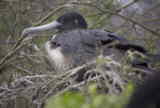 strike.
We have not found dragons but a lot of frigate birds, sealions and boobies.
These boobies do have blue feet. We walked over the island. It is a pity,
the frigate birds have been fare away and mostly behind bushes. The males
do have this red balloon, showing that they are
strike.
We have not found dragons but a lot of frigate birds, sealions and boobies.
These boobies do have blue feet. We walked over the island. It is a pity,
the frigate birds have been fare away and mostly behind bushes. The males
do have this red balloon, showing that they are
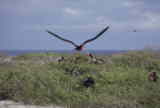 searching for
a female. We walked around the small island and returned to our sailer the
last time to have breakfast.
searching for
a female. We walked around the small island and returned to our sailer the
last time to have breakfast.
During our breakfast, the sailer navigates to
(#X). After breakfast
it was time
to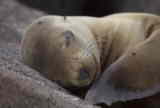 say good bye. We
disembark the sailer by the dinghy and returned by bus to the airport. The
most passengers from the sailer returned to their home country or to the
next adventure via Quito or Guayaquil now. I think
say good bye. We
disembark the sailer by the dinghy and returned by bus to the airport. The
most passengers from the sailer returned to their home country or to the
next adventure via Quito or Guayaquil now. I think
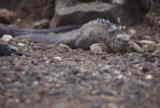 that
is very stressful, has nothing to do with vacation. I call it "self made
spare time stress". If you visit foreign countries you never will see everything,
you never can do everything. If you run behind every tourist attraction you
have been their physically. Have you been there mentally, have you been their
with your full and open mind. I can not imagine. My destination now was the
bus to the canal to return to Puerto Ayora for three days. I want to say
that
is very stressful, has nothing to do with vacation. I call it "self made
spare time stress". If you visit foreign countries you never will see everything,
you never can do everything. If you run behind every tourist attraction you
have been their physically. Have you been there mentally, have you been their
with your full and open mind. I can not imagine. My destination now was the
bus to the canal to return to Puerto Ayora for three days. I want to say
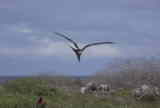 good
bye to the dragons at the police station, the pelicans and heron at the fish
market, the tortoise in the Darwin Station and, and, and ....
good
bye to the dragons at the police station, the pelicans and heron at the fish
market, the tortoise in the Darwin Station and, and, and ....
After a short bus ride I arrived at the canal an took the next
ferry to cross the small water. The bus
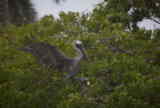 on
the other side would go in about two hours. So I took a taxi which is more
expensive but even faster. I arrived again at the hotel Red Booby and get
room number 9. I put my backpack into the room and walked over to the TAME
office to reconfirm my flight back to Guayaquil. That was not so easy. The
small building at the main road had two entries. I recognized
on
the other side would go in about two hours. So I took a taxi which is more
expensive but even faster. I arrived again at the hotel Red Booby and get
room number 9. I put my backpack into the room and walked over to the TAME
office to reconfirm my flight back to Guayaquil. That was not so easy. The
small building at the main road had two entries. I recognized
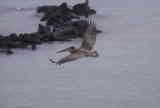 the right
entry only and that was the wrong one. The right entry is indicated as "cargo
office". Many people where waiting in line behind the counter. They wait
mainly to receive letters or small parcels. It took a while before the clerk
explained, that I had to use the left entry. Really, the left entry was indicated
as "travel office" and the steps leaded me up to the right office. I took
a number and the reconfirmation was done in a few minutes. It was around
noon and time to have lunch. Tis day I went into the back roads of Puerto
Ayora. There are small and very good but simple restaurants. Usually only
Santa Cruz people are in there. I had a fantastic lunch including drinks
for around four
the right
entry only and that was the wrong one. The right entry is indicated as "cargo
office". Many people where waiting in line behind the counter. They wait
mainly to receive letters or small parcels. It took a while before the clerk
explained, that I had to use the left entry. Really, the left entry was indicated
as "travel office" and the steps leaded me up to the right office. I took
a number and the reconfirmation was done in a few minutes. It was around
noon and time to have lunch. Tis day I went into the back roads of Puerto
Ayora. There are small and very good but simple restaurants. Usually only
Santa Cruz people are in there. I had a fantastic lunch including drinks
for around four
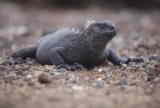 Dollars.
Dollars.
I spend the afternoon around the fish market, watching the fishermen, pelicans and frigate birds. The pelicans had enough food they just stand around and did the same like me. At the evening I checked for the dragons at the police station, they where gone. It starts to drizzle.
Tuesday, November 6th 2007
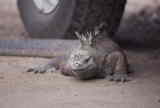 It seems there was some rain tonight. It is still drizzles. The sun tries
to break through the clouds. I had a fine breakfast in the hotel and went
to the police station to watch the dragons. Two very large dragons are there.
I tried to make pictures and lay down onto the ground. The large dragon told
me, I have to
leave
It seems there was some rain tonight. It is still drizzles. The sun tries
to break through the clouds. I had a fine breakfast in the hotel and went
to the police station to watch the dragons. Two very large dragons are there.
I tried to make pictures and lay down onto the ground. The large dragon told
me, I have to
leave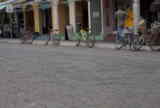 because
it is his area. Laying flat on the ground I guess I look like a large dragon.
The fishmarket was not busy this morning. Only a few pelicans waiting.
because
it is his area. Laying flat on the ground I guess I look like a large dragon.
The fishmarket was not busy this morning. Only a few pelicans waiting.
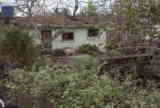 There
is no real espresso on Santa Cruz available. A normal coffee is available.
However, you always can order espresso. You will get a normal coffee served
in a small espresso cup. The price is the same as for a normal coffee. And
yes, the Galapagos Islands do have a coffee production. You can buy
There
is no real espresso on Santa Cruz available. A normal coffee is available.
However, you always can order espresso. You will get a normal coffee served
in a small espresso cup. The price is the same as for a normal coffee. And
yes, the Galapagos Islands do have a coffee production. You can buy
 real
Galapagos-Coffee.
real
Galapagos-Coffee.
I walked through Puerto Ayora, away from the waterfront. It is
a clean and nice little town. Clean does not mean that the houses are like
houses in e.g. Munich or
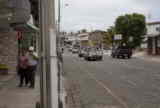 London.
The houses are small and around the property there is mostly a lot of material
e.g. to repair the roof or the doors. Sometimes the paint is a bit down from
the walls. But everything gives the impression of a cleaned
area.
London.
The houses are small and around the property there is mostly a lot of material
e.g. to repair the roof or the doors. Sometimes the paint is a bit down from
the walls. But everything gives the impression of a cleaned
area.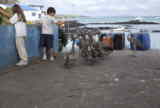 Never you have
to walk throught waste. The repair material always is placed in a "line"
on one point of the property. I have not seen dirty roads. A mechanist has
his repair shop outside.
Never you have
to walk throught waste. The repair material always is placed in a "line"
on one point of the property. I have not seen dirty roads. A mechanist has
his repair shop outside.
At noon I had lunch
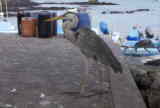 again in
a small restaurant away from the main road. Good food and drinks in a nice
restaurant with local people only. The people are very friendly.
Especially far away from the
waterfront.
again in
a small restaurant away from the main road. Good food and drinks in a nice
restaurant with local people only. The people are very friendly.
Especially far away from the
waterfront.
Later in the afternoon I went to the fish market again. It was busy their. Additional to the usual pelicans there was a great blue heron and some gulls. That heron is a very graceful bird. However, the heron always was in fight with the pelicans.
Wednesday, November 7th 2007
The last day on Galapagos, Santa Cruz. It is cloudy. Seems it will drizzle soon. Nothing happen at the fish market. On the way to the Darwin Station there was a large dragon just on the way. In the lagoon close to the Darwin Station entrance there was a blue heron building a nest. Later at the police station again several large dragons. I wished them good luck and good bye!
Thursday, November 8th 2007
Leaving. Getting up at 5 o'clock in the morning. Breakfast at 6 o'clock. Then a taxi drive to the airport, no, to the canal, crossing the canal by boat and going by bus to the airport. No dragons. It seems they clean the airport on Mondays only. No cleaning crew today. I leave the "Island of the Dragons", direction Guayaquil. I know, I need to come back one day to see the dragons again!
Guayaquil has a very modern airport. Outside green with water and fish. Inside even the displays work well. It is morning. The connection to Madrid is in the evening. There is no possibility to secure the luggage, no way to go into Guayaquil.
The people are friendly and they try to help always.
Afternoon, the check-in procedure starts. Such flight seems to be very important for the people, like a family meeting. About 5 times more people as passengers are waiting. When the "real" check-in queue starts, only people with tickets may enter the queue-way directing to the check-in counters. After check-in I had to pay $26, the fee to leave Ecuador. Passing the security I stand inside a large shop, selling such unnecessary smelling stuff.... Boarding, my thoughts are with the dragons .... leaving for Madrid.......
Friday, November 9th 2007
..... arrive at Madrid airport in the morning. Heading to the terminal going to Munich, passing the procedure to enter the European Union.
Boarding....... arrive Munich airport in the afternoon, no dragons anymore.
Last modification: September 11 - 2009 DF2IR